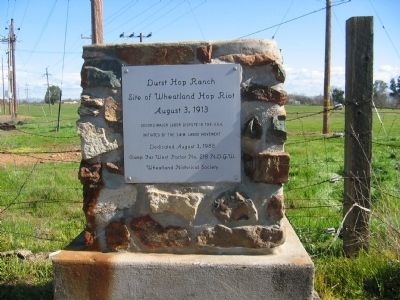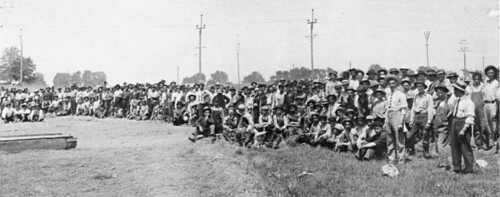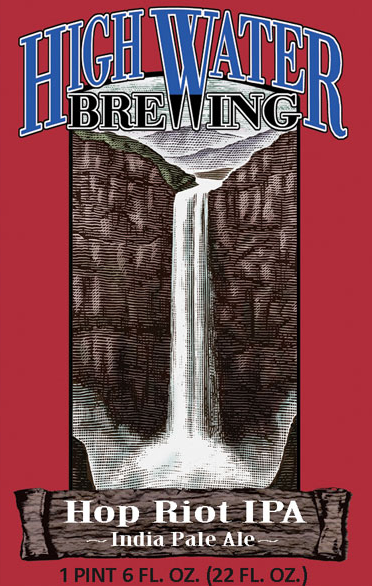![]()
Today marks the 100th anniversary of the Wheatland Hop Riot, a seminal event in labor relations, the second major labor dispute in U.S. history, and the first event to shine a light on the plight of agricultural workers and their conditions. It was for this event that High Water Brewing named their Hop Riot IPA, as its name pays homage to the legacy of hops in California, which before prohibition was the largest hop-growing state in the U.S.

Here’s one account on the riot, this one from True West:
In the region northeast of Sacramento, field temperatures had hit the 120s—tough working conditions for the migrants harvesting hops, the green plant (related to hemp) used in brewing beer.
The work was hard, and the season short (by the end of August, the migrants would be moving on). The Durst Ranch, the largest agricultural employer in California, needed about 1,500 workers; nearly double showed up. Most workers made less than $1.50 a day—big pay in a time of national recession.
Conditions were hellish. Workers had to buy water (contaminated by acetic acid) for five cents, plus food and other supplies from a price-gouging company store. Dysentery was rampant, with less than a dozen toilets available for workers. Garbage and refuse cluttered the area. (In all fairness, the situation at the Durst Ranch was not unusual for California operations that hired migrants.)
Richard “Blackie” Ford, a former organizer for the radical Industrial Workers of the World, decided to mobilize the Durst Ranch workers to get higher pay and better conditions. He presented a list of demands to Durst on August 3. The rancher agreed to all of them—regular ice-water breaks (at no charge), more toilets and so forth. But he wouldn’t boost the pay.
Ford said that wasn’t good enough; some accounts state Durst responded by slapping Ford in the mouth. The labor man then went to a nearby platform to harangue the workers. Durst went into town to get the authorities.
The rancher returned with a couple carloads of men, including Yuba County Sheriff George Voss, Deputy Eugene Reardon and District Attorney Ed Manwell. They arrived shortly after five p.m., and Ford had the crowd worked up.
Just what happened next depends on which side you believe. The authorities and Durst claimed that some workers had attacked them. Ford and the migrants said the lawmen had opened fire on them. Either way, a melee ensued.
When it was done, Manwell, Reardon and two workers were dead. Sheriff Voss was severely injured, as were an untold number of folks on both sides. Ford was on the run, and most of the workers had scattered to the four winds. The day became known as “Bloody Sunday.”
Ford and organizer Herman Suhr were arrested. Neither participated in the attacks, but officials accused them of inciting the violence and charged them with murder.
The trial took place in January 1914 in nearby Marysville. Most locals (including jury members) weren’t sympathetic to the union or the migrants. Both defendants were found guilty of second-degree murder and given life sentences. The proceedings received international press coverage.
After the incident, the Durst Ranch gave in to all the demands, including the higher pay. The hop crop was brought in without any further trouble.
Ford was pardoned in 1924, and Suhr paroled two years later.

Another account, suggests that Durst was hardly blameless, and at least shared responsibility by the way he tricked and treated his workers, a not uncommon occurrence at that time.
An important and highly-publicized event in California labor history, it was the second major labor dispute in the United States supposedly initiated by the Industrial Workers of the World. The bloody clash, which occurred at the Durst Ranch in Wheatland, California, was the climax of growing tensions brought about by the difficult conditions farm laborers at the ranch endured. The riot resulted in four deaths and many injuries. It focused public opinion for the first time on the plight of California’s agricultural laborers, and resulted in new state legislation to regulate labor camp conditions. A new State Commission on Immigration and Housing was created to help improve working conditions. The Wheatland Hop Riot was also the first major farm labor confrontation in California and a harbinger of decades of attempts to organize or control agricultural labor.
Durst advertised for 3000 hop pickers and other seasonal agricultural workers, though he only needed half that number — in order to drive wages down. Of a $1.50/ day wage, $0.78 – $1.00 was withheld from the workers’ pay. If a worker didn’t stay till the end of the season, Durst kept that withheld money. Durst then had the workers harassed, cheated, and abused to try to make them leave before the end of the season. The strikers demanded water twice a day, separate bathrooms for men and women, and higher pay. During a speech by Richard “Blackie” Ford, the Yuba County sheriff and a group of over 100 vigilantes fired into the crowd of workers, causing the riot. Two workers, a deputy, and the district attorney were killed. The National Guard was ordered into the area and 100 workers arrested.

In addition, libcom.org has an account of the hop riot and the Sacramento Bee has their version to commemorate the 100th anniversary this year that was posted a few days ago. You can also read more about the Wheatland Hop Riot at Wikipedia, too.
David A. Kulczyk also wrote an interesting, more labor-friendly, account, published in 2007, entitled “Hops of Wrath, 1913’s bloody Wheatland Hop Riot eventually led to better conditions for workers. Too bad it was only temporary” and LaborNet has the Legacy of Wheatland.

So tonight, drink a toast to the men and women of the Wheatland Hop Rio, and make it a High Water Hop Riot IPA.

